Effect of High-Voltage Electric Field on Thawing Kinetics and Quality Characteristics of Frozen Beef
Abstract
:1. Introduction
2. Materials and Methods
2.1. Sample Preparation and Processing
2.2. Experimental Equipment and Instruments
2.3. Experimental Method
2.4. Thawing Rate and Thawing Time
2.5. Evaporation Loss
2.6. Drip Loss
2.7. Cooking Loss
2.8. Total Loss
2.9. WHC
2.10. Ion Wind Speed
2.11. Color
2.12. Malondialdehyde Content
2.13. Scanning Electron Microscopy (SEM)
2.14. FTIR Spectroscopy
2.15. Protein Secondary Structure
2.16. Low-Field Nuclear Magnetic Resonance (LF-NMR)
2.17. Statistical Analysis
3. Results and Discussion
3.1. Analysis of the Thawing Process
3.2. Thawing Loss
3.3. WHC
3.4. Color
3.5. Malondialdehyde Content
3.6. Microstructure
3.7. FTIR Spectroscopy
3.8. Protein Secondary Structure
3.9. Low-Field Nuclear Magnetic Resonance (LF-NMR)
4. Conclusions
Author Contributions
Funding
Data Availability Statement
Conflicts of Interest
References
- OECD/FAO. OECD-FAO Agricultural Outlook 2019–2028; OECD: Paris, France, 2019. [Google Scholar] [CrossRef]
- Wu, B.; Qiu, C.; Guo, Y.; Zhang, C.; Guo, X.; Bouhile, Y.; Ma, H. Ultrasonic-assisted flowing water thawing of frozen beef with different frequency modes: Effects on thawing efficiency, quality characteristics and microstructure. Food Res. Int. 2022, 157, 111484. [Google Scholar] [CrossRef] [PubMed]
- Egelandsdal, B.; Abie, S.M.; Bjarnadottir, S.; Zhu, H.; Kolstad, H.; Bjerke, F.; Martinsen, Ø.G.; Mason, A.; Münch, D. Detectability of the degree of freeze damage in meat depends on analytic-tool selection. Meat Sci. 2019, 152, 8–19. [Google Scholar] [CrossRef] [PubMed]
- Dalvi-Isfahan, M.; Hamdami, N.; Le-Bail, A. Effect of freezing under electrostatic field on the quality of lamb meat. Innov. Food Sci. Emerg. Technol. 2016, 37, 68–73. [Google Scholar] [CrossRef]
- Xia, X.; Kong, B.; Liu, Q.; Liu, J. Physicochemical change and protein oxidation in porcine longissimus dorsi as influenced by different freeze–thaw cycles. Meat Sci. 2009, 83, 239–245. [Google Scholar] [CrossRef]
- Eui-Soo, L.; Jong-Youn, J.; Long-Hao, Y.; Ji-Hun, C.; Doo-Jeong, H.; Yun-Sang, C.; Cheon-Jei, K. Effects of Thawing Temperature on the Physicochemical and Sensory Properties of Frozen Pre-Rigor Beef Muscle. Food Sci. Biotechnol. 2007, 16, 626–631. [Google Scholar]
- Eastridge, J.S.; Bowker, B.C. Effect of Rapid Thawing on the Meat Quality Attributes of USDA Select Beef Strip Loin Steaks. J. Food Sci. 2011, 76, S156–S162. [Google Scholar] [CrossRef] [PubMed]
- Shrestha, S.; Schaffner, D.; Nummer, B.A. Sensory quality and food safety of boneless chicken breast portions thawed rapidly by submersion in hot water. Food Control 2009, 20, 706–708. [Google Scholar] [CrossRef]
- Icier, F.; Izzetoglu, G.T.; Bozkurt, H.; Ober, A. Effects of ohmic thawing on histological and textural properties of beef cuts. J. Food Eng. 2010, 99, 360–365. [Google Scholar] [CrossRef]
- Sun, Q.; Kong, B.; Liu, S.; Zheng, O.; Zhang, C. Ultrasound-assisted thawing accelerates the thawing of common carp (Cyprinus carpio) and improves its muscle quality. LWT 2021, 141, 111080. [Google Scholar] [CrossRef]
- Uyar, R.; Bedane, T.F.; Erdogdu, F.; Koray Palazoglu, T.; Farag, K.W.; Marra, F. Radio-frequency thawing of food products—A computational study. J. Food Eng. 2015, 146, 163–171. [Google Scholar] [CrossRef]
- Cai, L.; Cao, M.; Cao, A.; Regenstein, J.; Li, J.; Guan, R. Ultrasound or microwave vacuum thawing of red seabream (Pagrus major) fillets. Ultrason. Sonochem. 2018, 47, 122–132. [Google Scholar] [CrossRef]
- Taher, B.J.; Farid, M.M. Cyclic microwave thawing of frozen meat: Experimental and theoretical investigation. Chem. Eng. Process. Process Intensif. 2001, 40, 379–389. [Google Scholar] [CrossRef]
- Cai, L.; Zhang, W.; Cao, A.; Cao, M.; Li, J. Effects of ultrasonics combined with far infrared or microwave thawing on protein denaturation and moisture migration of Sciaenops ocellatus (red drum). Ultrason. Sonochem. 2019, 55, 96–104. [Google Scholar] [CrossRef] [PubMed]
- Lv, F.; Song, J.; Wang, P.; Ruan, H.; Geng, J. Influencing Factors of Flow Field of Ionic Wind Induced by Corona Discharge in a Multi-Needle-to-Net Electrode Structure Under Direct-Current Voltage. IEEE Access 2019, 7, 123671–123678. [Google Scholar] [CrossRef]
- Larick, D.K.; Turner, B.E. Aseptic Processing of Beef Particulates: Flavor Development/Stability and Texture. J. Food Sci. 1992, 57, 1046–1050. [Google Scholar] [CrossRef]
- He, X.; Jia, G.; Tatsumi, E.; Liu, H. Effect of corona wind, current, electric field and energy consumption on the reduction of the thawing time during the high-voltage electrostatic-field (HVEF) treatment process. Innov. Food Sci. Emerg. Technol. 2016, 34, 135–140. [Google Scholar] [CrossRef]
- Orlowska, M.; Havet, M.; Le-Bail, A. Controlled ice nucleation under high voltage DC electrostatic field conditions. Food Res. Int. 2009, 42, 879–884. [Google Scholar] [CrossRef]
- Rahbari, M.; Hamdami, N.; Mirzaei, H.; Jafari, S.M.; Kashaninejad, M.; Khomeiri, M. Effects of high voltage electric field thawing on the characteristics of chicken breast protein. J. Food Eng. 2018, 216, 98–106. [Google Scholar] [CrossRef]
- Amiri, A.; Mousakhani-Ganjeh, A.; Shafiekhani, S.; Mandal, R.; Singh, A.P.; Kenari, R.E. Effect of high voltage electrostatic field thawing on the functional and physicochemical properties of myofibrillar proteins. Innov. Food Sci. Emerg. Technol. 2019, 56, 102191. [Google Scholar] [CrossRef]
- Kantono, K.; Hamid, N.; Oey, I.; Wang, S.; Xu, Y.; Ma, Q.; Faridnia, F.; Farouk, M. Physicochemical and sensory properties of beef muscles after Pulsed Electric Field processing. Food Res. Int. 2019, 121, 1–11. [Google Scholar] [CrossRef]
- Ding, C.; Ni, J.; Song, Z.; Gao, Z.; Deng, S.; Xu, J.; Wang, G.; Bai, Y. High-Voltage Electric Field-Assisted Thawing of Frozen Tofu: Effect of Process Parameters and Electrode Configuration. J. Food Qual. 2018, 2018, 5191075. [Google Scholar] [CrossRef]
- Ni, J.; Ding, C.; Zhang, Y.; Song, Z. Impact of different pretreatment methods on drying characteristics and microstructure of goji berry under electrohydrodynamic (EHD) drying process. Innov. Food Sci. Emerg. Technol. 2020, 61, 102318. [Google Scholar] [CrossRef]
- Mousakhani-Ganjeh, A.; Hamdami, N.; Soltanizadeh, N. Effect of high voltage electrostatic field thawing on the lipid oxidation of frozen tuna fish (Thunnus albacares). Innov. Food Sci. Emerg. Technol. 2016, 36, 42–47. [Google Scholar] [CrossRef]
- Alizadeh, E.; Chapleau, N.; De Lamballerie, M.; LeBail, A. Effects of Freezing and Thawing Processes on the Quality of Atlantic Salmon (Salmo salar) Fillets. J. Food Sci. 2007, 72, E279–E284. [Google Scholar] [CrossRef]
- Li, C.; Wang, D.; Xu, W.; Gao, F.; Zhou, G. Effect of final cooked temperature on tenderness, protein solubility and microstructure of duck breast muscle. LWT Food Sci. Technol. 2013, 51, 266–274. [Google Scholar] [CrossRef]
- Jia, G.; Liu, H.; Nirasawa, S.; Liu, H. Effects of high-voltage electrostatic field treatment on the thawing rate and post-thawing quality of frozen rabbit meat. Innov. Food Sci. Emerg. Technol. 2017, 41, 348–356. [Google Scholar] [CrossRef]
- Jia, G.; van den Berg, F.; Hao, H.; Liu, H. Estimating the structure of sarcoplasmic proteins extracted from pork tenderloin thawed by a high-voltage electrostatic field. J. Food Sci. Technol. 2020, 57, 1574–1578. [Google Scholar] [CrossRef]
- Reitznerová, A.; Šuleková, M.; Nagy, J.; Marcinčák, S.; Semjon, B.; Čertík, M.; Klempová, T. Lipid Peroxidation Process in Meat and Meat Products: A Comparison Study of Malondialdehyde Determination between Modified 2-Thiobarbituric Acid Spectrophotometric Method and Reverse-Phase High-Performance Liquid Chromatography. Molecules 2017, 22, 1988. [Google Scholar] [CrossRef]
- Palka, K.; Daun, H. Changes in texture, cooking losses, and myofibrillar structure of bovine M. semitendinosus during heating. Meat Sci. 1999, 51, 237–243. [Google Scholar] [CrossRef]
- Bakal, A.; Hayakawa, K.-I. Heat Transfer During Freezing and Thawing of Foods. Adv. Food Res. 1973, 20, 217–256. [Google Scholar] [CrossRef]
- He, X.; Liu, R.; Nirasawa, S.; Zheng, D.; Liu, H. Effect of high voltage electrostatic field treatment on thawing characteristics and post-thawing quality of frozen pork tenderloin meat. J. Food Eng. 2013, 115, 245–250. [Google Scholar] [CrossRef]
- Sun, Q.; Zhang, M.; Mujumdar, A.S. Recent developments of artificial intelligence in drying of fresh food: A review. Crit. Rev. Food Sci. Nutr. 2019, 59, 2258–2275. [Google Scholar] [CrossRef] [PubMed]
- Ge, X.; Wang, H.; Yin, M.; Wang, X. Effect of Different Thawing Methods on the Physicochemical Properties and Microstructure of Frozen Instant Sea Cucumber. Foods 2022, 11, 2616. [Google Scholar] [CrossRef] [PubMed]
- Bai, Y.; Huo, Y.; Fan, X. Experiment of thawing shrimps (Penaeus vannamei) with high voltage electric field. Int. J. Appl. Electromagn. Mech. 2017, 55, 499–506. [Google Scholar] [CrossRef]
- Dalvi-Isfahan, M.; Hamdami, N.; Le-Bail, A.; Xanthakis, E. The principles of high voltage electric field and its application in food processing: A review. Food Res. Int. 2016, 89, 48–62. [Google Scholar] [CrossRef] [PubMed]
- Jia, G.; Sha, K.; Meng, J.; Liu, H. Effect of high voltage electrostatic field treatment on thawing characteristics and post-thawing quality of lightly salted, frozen pork tenderloin. LWT 2019, 99, 268–275. [Google Scholar] [CrossRef]
- Cai, L.; Cao, M.; Regenstein, J.; Cao, A. Recent Advances in Food Thawing Technologies. Compr. Rev. Food Sci. Food Saf. 2019, 18, 953–970. [Google Scholar] [CrossRef]
- Mousakhani-Ganjeh, A.; Hamdami, N.; Soltanizadeh, N. Impact of high voltage electric field thawing on the quality of frozen tuna fish (Thunnus albacares). J. Food Eng. 2015, 156, 39–44. [Google Scholar] [CrossRef]
- Hsieh, C.-W.; Lai, C.-H.; Ho, W.-J.; Huang, S.-C.; Ko, W.-C. Effect of Thawing and Cold Storage on Frozen Chicken Thigh Meat Quality by High-Voltage Electrostatic Field. J. Food Sci. 2010, 75, M193–M197. [Google Scholar] [CrossRef]
- Xie, Y.; Zhou, K.; Chen, B.; Wang, Y.; Nie, W.; Wu, S.; Wang, W.; Li, P.; Xu, B. Applying low voltage electrostatic field in the freezing process of beef steak reduced the loss of juiciness and textural properties. Innov. Food Sci. Emerg. Technol. 2021, 68, 102600. [Google Scholar] [CrossRef]
- Li, D.; Jia, S.; Zhang, L.; Li, Q.; Pan, J.; Zhu, B.; Prinyawiwatkul, W.; Luo, Y. Post-thawing quality changes of common carp (Cyprinus carpio) cubes treated by high voltage electrostatic field (HVEF) during chilled storage. Innov. Food Sci. Emerg. Technol. 2017, 42, 25–32. [Google Scholar] [CrossRef]
- Hong, H.; Luo, Y.; Zhou, Z.; Bao, Y.; Lu, H.; Shen, H. Effects of different freezing treatments on the biogenic amine and quality changes of bighead carp (Aristichthys nobilis) heads during ice storage. Food Chem. 2013, 138, 1476–1482. [Google Scholar] [CrossRef] [PubMed]
- Huff-Lonergan, E. 6—Fresh meat water-holding capacity. In Improving the Sensory and Nutritional Quality of Fresh Meat; Kerry, J.P., Ledward, D., Eds.; Woodhead Publishing: Sawston, UK, 2009; pp. 147–160. [Google Scholar]
- Li, F.; Wang, B.; Liu, Q.; Chen, Q.; Zhang, H.; Xia, X.; Kong, B. Changes in myofibrillar protein gel quality of porcine longissimus muscle induced by its stuctural modification under different thawing methods. Meat Sci. 2019, 147, 108–115. [Google Scholar] [CrossRef] [PubMed]
- Testa, M.L.; Grigioni, G.; Panea, B.; Pavan, E. Color and Marbling as Predictors of Meat Quality Perception of Argentinian Consumers. Foods 2021, 10, 1465. [Google Scholar] [CrossRef]
- Xia, X.; Kong, B.; Liu, J.; Diao, X.; Liu, Q. Influence of different thawing methods on physicochemical changes and protein oxidation of porcine longissimus muscle. LWT Food Sci. Technol. 2012, 46, 280–286. [Google Scholar] [CrossRef]
- Holman, B.W.B.; van de Ven, R.J.; Mao, Y.; Coombs, C.E.O.; Hopkins, D.L. Using instrumental (CIE and reflectance) measures to predict consumers’ acceptance of beef colour. Meat Sci. 2017, 127, 57–62. [Google Scholar] [CrossRef]
- Kim, J.-G.; Yousef, A.E.; Dave, S. Application of Ozone for Enhancing the Microbiological Safety and Quality of Foods: A Review. J. Food Prot. 1999, 62, 1071–1087. [Google Scholar] [CrossRef]
- Park, D.; Xiong, Y.L.; Alderton, A.L.; Ooizumi, T. Biochemical Changes in Myofibrillar Protein Isolates Exposed to Three Oxidizing Systems. J. Agric. Food Chem. 2006, 54, 4445–4451. [Google Scholar] [CrossRef]
- Falowo, A.B.; Fayemi, P.O.; Muchenje, V. Natural antioxidants against lipid–protein oxidative deterioration in meat and meat products: A review. Food Res. Int. 2014, 64, 171–181. [Google Scholar] [CrossRef]
- Domínguez, R.; Pateiro, M.; Gagaoua, M.; Barba, F.J.; Zhang, W.; Lorenzo, J.M. A Comprehensive Review on Lipid Oxidation in Meat and Meat Products. Antioxidants 2019, 8, 429. [Google Scholar] [CrossRef]
- Ke, Z.; Bai, Y.; Bai, Y.; Chu, Y.; Gu, S.; Xiang, X.; Ding, Y.; Zhou, X. Cold plasma treated air improves the characteristic flavor of Dry-cured black carp through facilitating lipid oxidation. Food Chem. 2022, 377, 131932. [Google Scholar] [CrossRef] [PubMed]
- Lung, C.T.; Chang, C.K.; Cheng, F.C.; Hou, C.Y.; Chen, M.H.; Santoso, S.P.; Yudhistira, B.; Hsieh, C.W. Effects of pulsed electric field-assisted thawing on the characteristics and quality of Pekin duck meat. Food Chem. 2022, 390, 133137. [Google Scholar] [CrossRef] [PubMed]
- Zhao, M.; Downey, G.; O’Donnell, C.P. Exploration of microwave dielectric and near infrared spectroscopy with multivariate data analysis for fat content determination in ground beef. Food Control 2016, 68, 260–270. [Google Scholar] [CrossRef]
- Candoğan, K.; Altuntas, E.G.; İğci, N. Authentication and Quality Assessment of Meat Products by Fourier-Transform Infrared (FTIR) Spectroscopy. Food Eng. Rev. 2021, 13, 66–91. [Google Scholar] [CrossRef]
- Chen, Y.; Zou, C.; Mastalerz, M.; Hu, S.; Gasaway, C.; Tao, X. Applications of Micro-Fourier Transform Infrared Spectroscopy (FTIR) in the Geological Sciences—A Review. Int. J. Mol. Sci. 2015, 16, 30223–30250. [Google Scholar] [CrossRef]
- Lucarini, M.; Durazzo, A.; Sánchez del Pulgar, J.; Gabrielli, P.; Lombardi-Boccia, G. Determination of fatty acid content in meat and meat products: The FTIR-ATR approach. Food Chem. 2018, 267, 223–230. [Google Scholar] [CrossRef]
- Deniz, E.; Güneş Altuntaş, E.; Ayhan, B.; İğci, N.; Özel Demiralp, D.; Candoğan, K. Differentiation of beef mixtures adulterated with chicken or turkey meat using FTIR spectroscopy. J. Food Process. Preserv. 2018, 42, e13767. [Google Scholar] [CrossRef]
- Pebriana, R.; Rohman, A.; Lukitaningsih, E.; Sudjadi. Development of FTIR spectroscopy in combination with chemometrics for analysis of rat meat in beef sausage employing three lipid extraction systems. Int. J. Food Prop. 2017, 20, 1–11. [Google Scholar] [CrossRef]
- Zhao, X.; Han, G.; Wen, R.; Xia, X.; Chen, Q.; Kong, B. Influence of lard-based diacylglycerol on rheological and physicochemical properties of thermally induced gels of porcine myofibrillar protein at different NaCl concentrations. Food Res. Int. 2020, 127, 108723. [Google Scholar] [CrossRef]
- Acero-Lopez, A.; Ullah, A.; Offengenden, M.; Jung, S.; Wu, J. Effect of high pressure treatment on ovotransferrin. Food Chem. 2012, 135, 2245–2252. [Google Scholar] [CrossRef]
- Sun, Z.; Yang, F.-W.; Li, X.; Zhang, C.-h.; Xie, X.-l. Effects of Freezing and Thawing Treatments on Beef Protein Secondary Structure Analyzed with ATR-FTIR. Guang Pu Xue Yu Guang Pu Fen Xi = Guang Pu 2016, 36, 3542–3546. [Google Scholar] [PubMed]
- Yang, H.; Zhang, W.; Li, T.; Zheng, H.; Khan, M.A.; Xu, X.; Sun, J.; Zhou, G. Effect of protein structure on water and fat distribution during meat gelling. Food Chem. 2016, 204, 239–245. [Google Scholar] [CrossRef] [PubMed]
- Zhang, Z.; Yang, Y.; Zhou, P.; Zhang, X.; Wang, J. Effects of high pressure modification on conformation and gelation properties of myofibrillar protein. Food Chem. 2017, 217, 678–686. [Google Scholar] [CrossRef]
- Mohsenpour, M.; Nourani, M.; Enteshary, R. Effect of thawing under an alternating magnetic field on rainbow trout (Oncorhynchus mykiss) fillet characteristics. Food Chem. 2023, 402, 134255. [Google Scholar] [CrossRef] [PubMed]
- Pearce, K.L.; Rosenvold, K.; Andersen, H.J.; Hopkins, D.L. Water distribution and mobility in meat during the conversion of muscle to meat and ageing and the impacts on fresh meat quality attributes—A review. Meat Sci. 2011, 89, 111–124. [Google Scholar] [CrossRef] [PubMed]
- Zheng, J.; Sun, D.; Liu, D.; Sun, J.; Shao, J.-H. Low-field NMR and FTIR determination relationship between water migration and protein conformation of the preparation of minced meat. Int. J. Food Sci. Technol. 2022, 57, 235–241. [Google Scholar] [CrossRef]
- Zhang, M.; Haili, N.; Chen, Q.; Xia, X.; Kong, B. Influence of ultrasound-assisted immersion freezing on the freezing rate and quality of porcine longissimus muscles. Meat Sci. 2018, 136, 1–8. [Google Scholar] [CrossRef]
- Qian, S.; Li, X.; Wang, H.; Mehmood, W.; Zhong, M.; Zhang, C.; Blecker, C. Effects of low voltage electrostatic field thawing on the changes in physicochemical properties of myofibrillar proteins of bovine Longissimus dorsi muscle. J. Food Eng. 2019, 261, 140–149. [Google Scholar] [CrossRef]
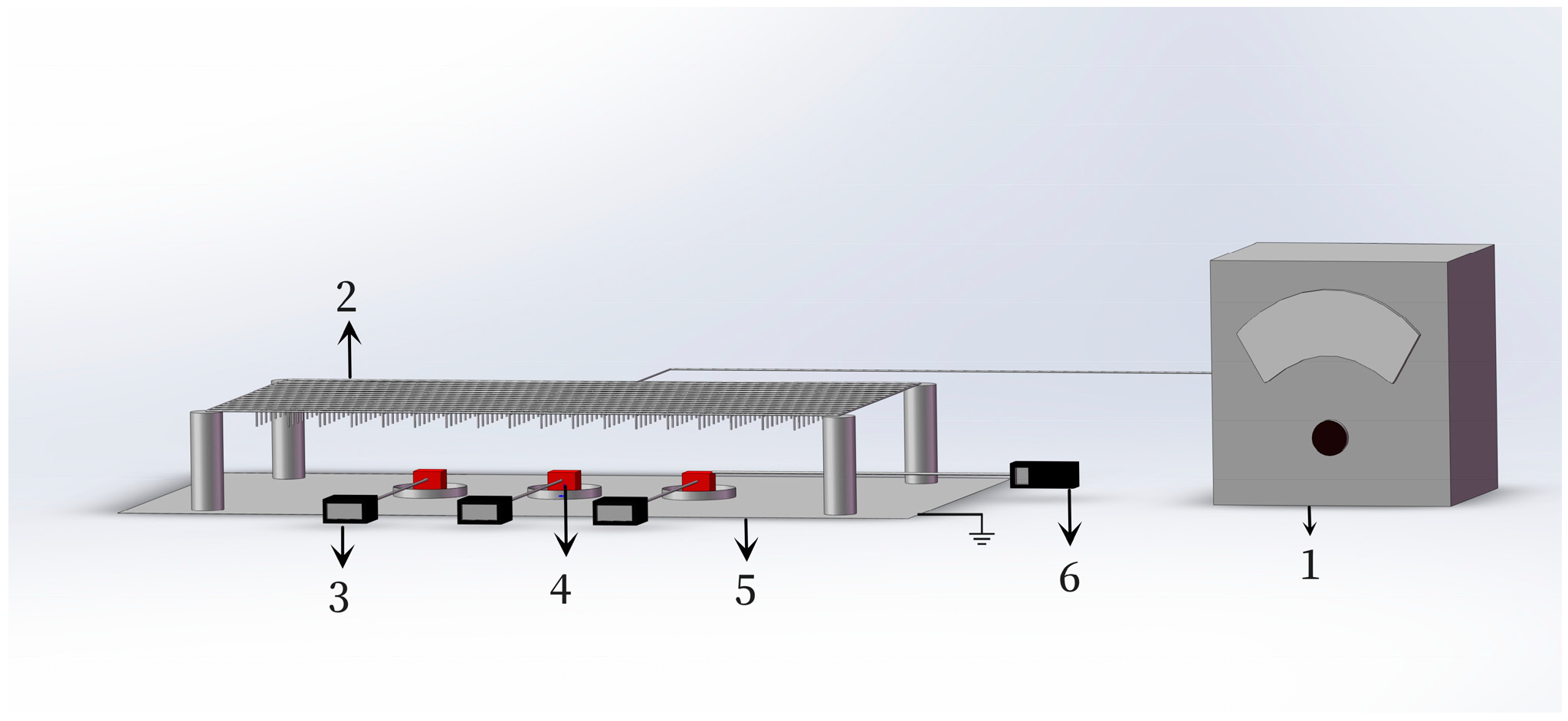
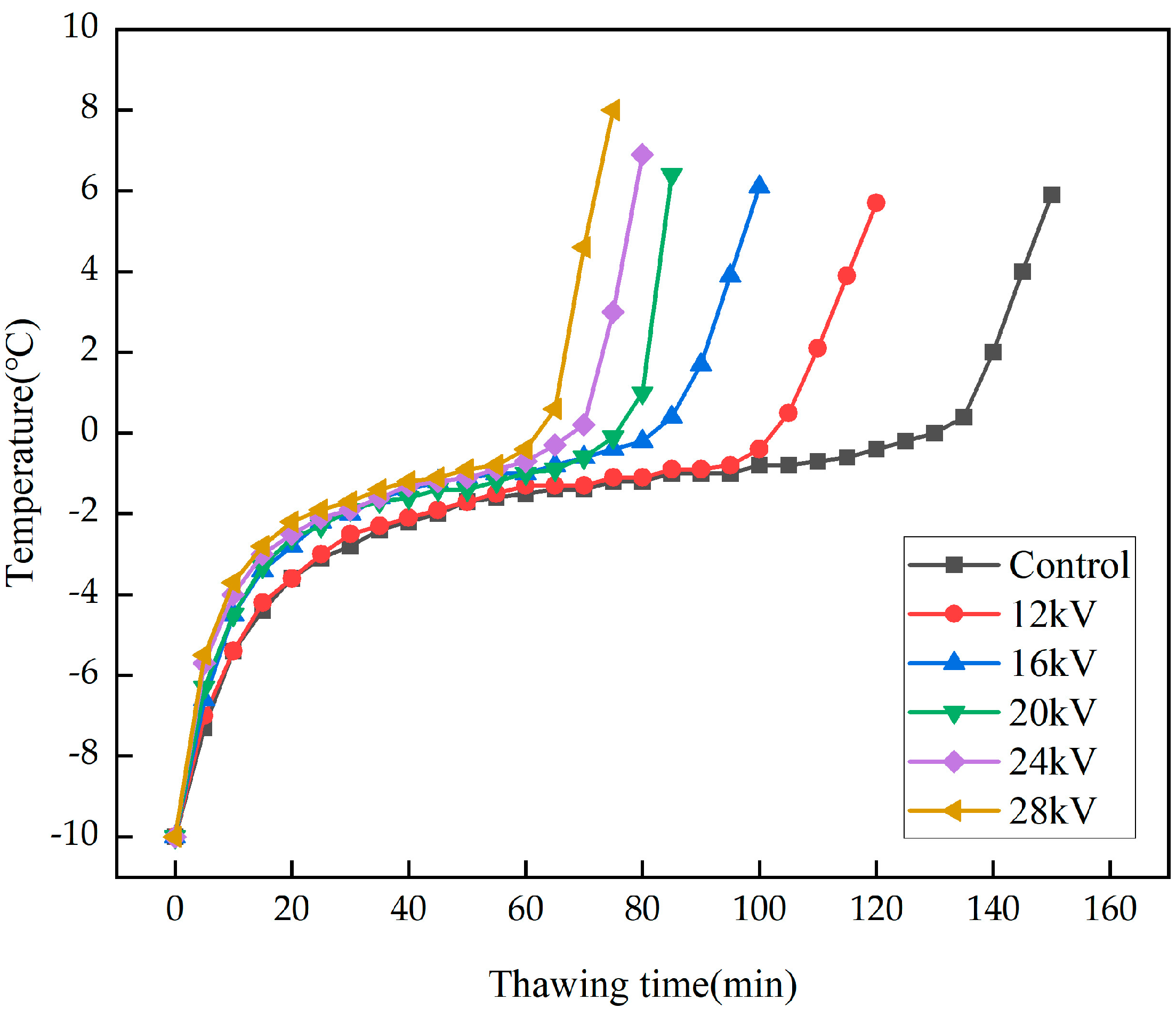
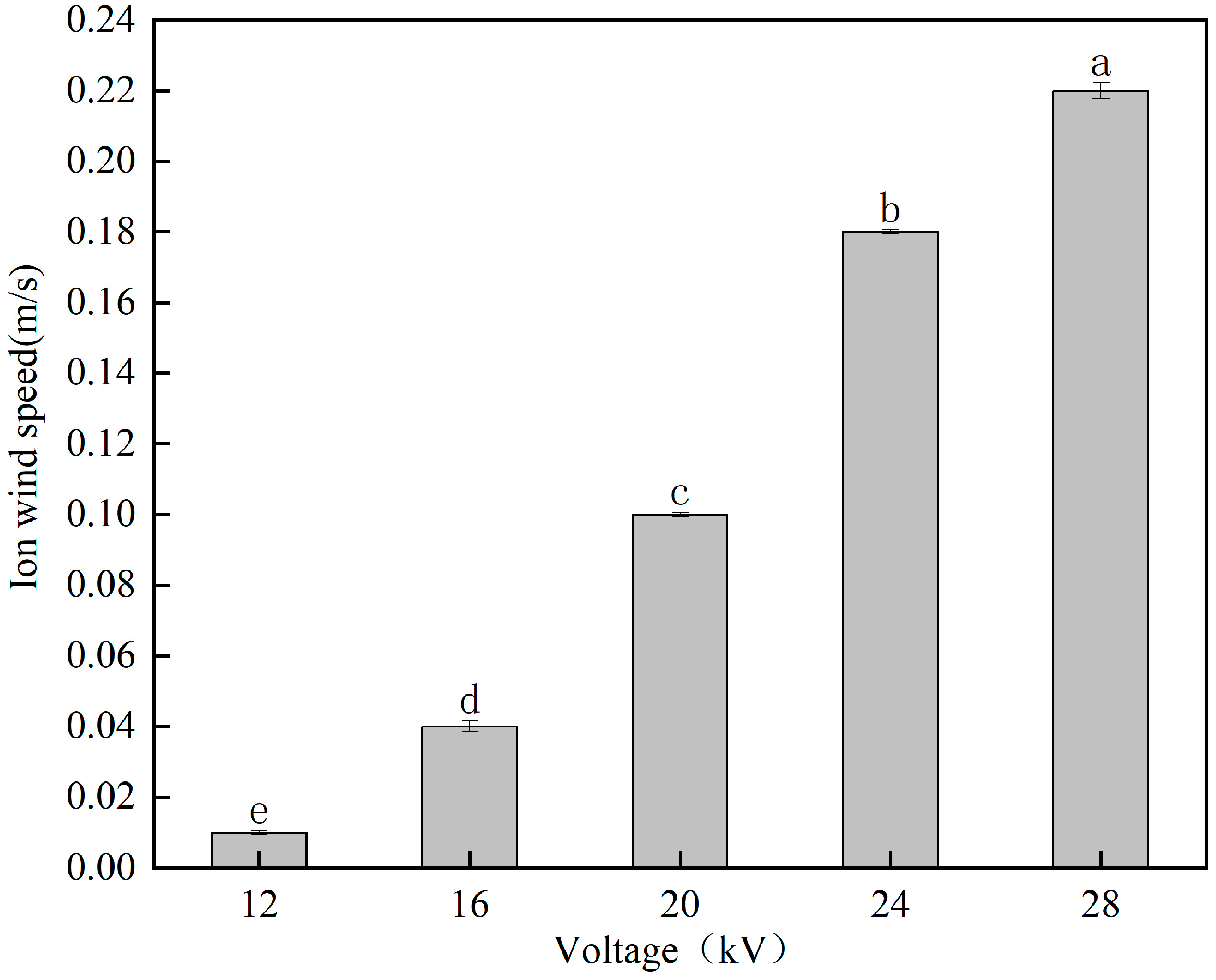
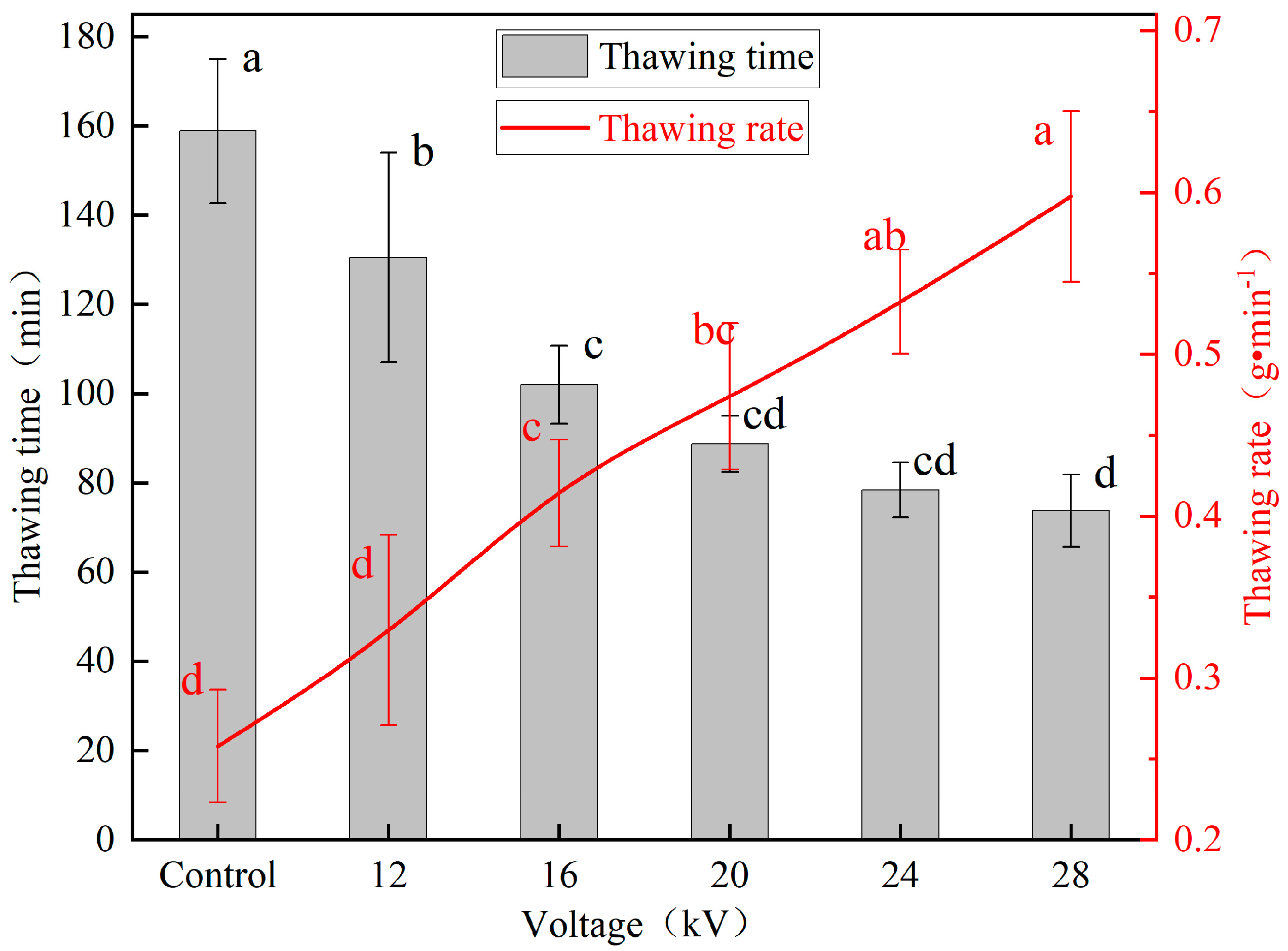



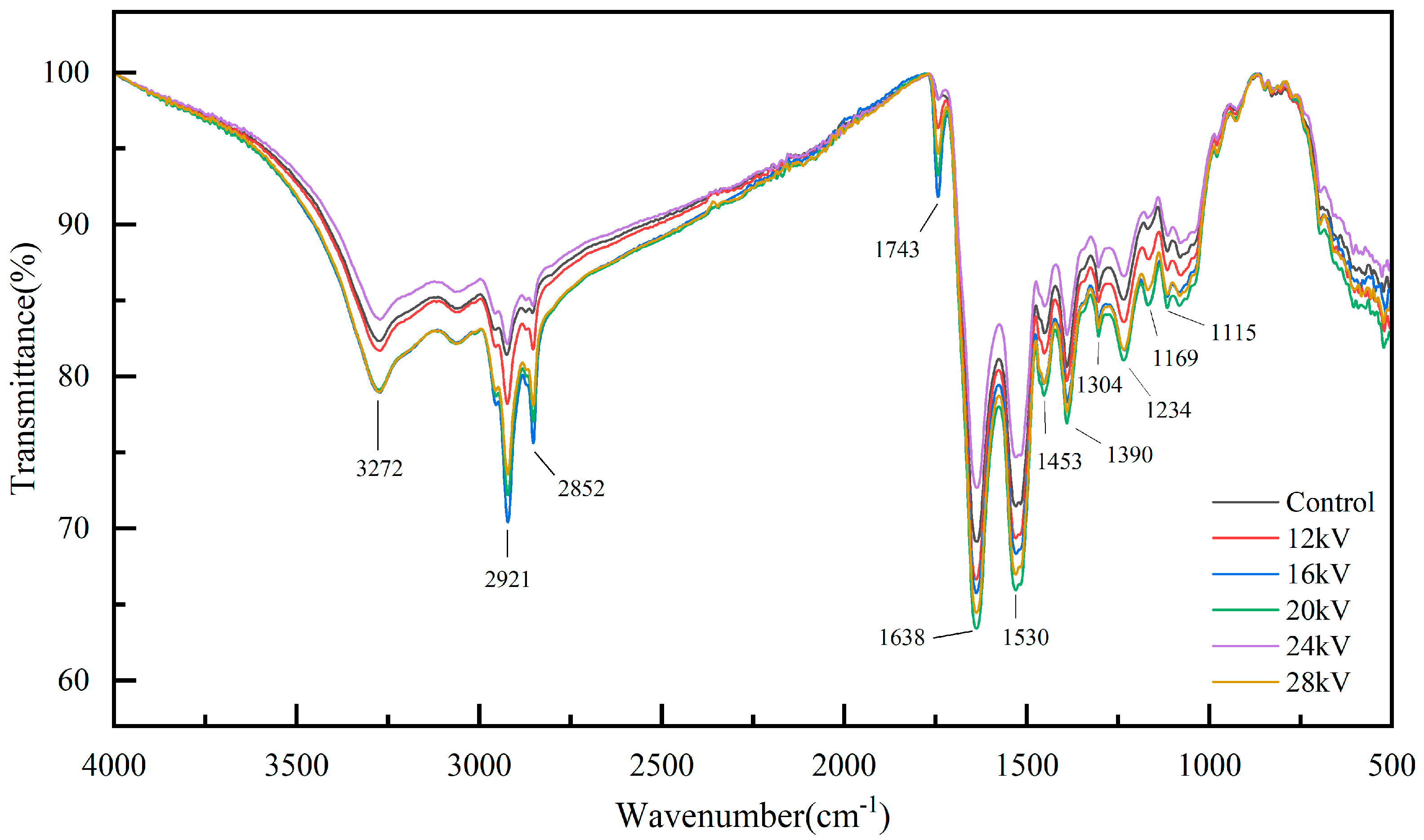
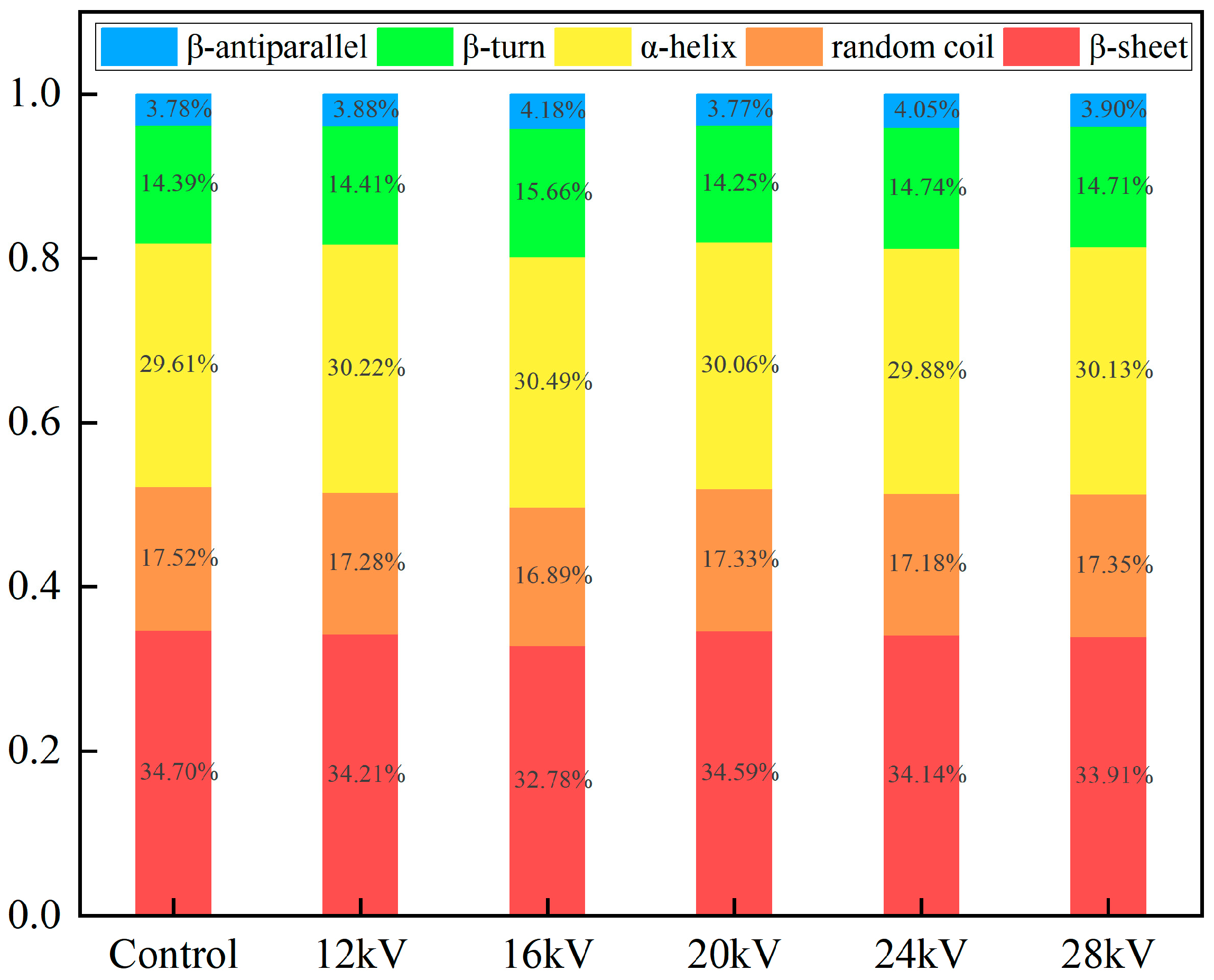



| Loss | Control | 12 kV | 16 kV | 20 kV | 24 kV | 28 kV |
|---|---|---|---|---|---|---|
| Evaporation loss | 1.06 ± 0.23 d | 1.84 ± 0.16 c | 2.07 ± 0.11 c | 2.75 ± 0.44 b | 3.4 ± 0.25 a | 3.67 ± 0.34 a |
| Drip loss | 10.61 ± 2.85 a | 9.09 ± 1.85 ab | 8.1 ± 1.83 ab | 6.28 ± 1.82 bc | 4.38 ± 1.4 c | 3.21 ± 0.54 c |
| Cooking loss | 48.35 ± 0.08 a | 47.45 ± 0.83 ab | 46.21 ± 1.52 bc | 45.34 ± 1.57 c | 46.77 ± 0.73 abc | 47.32 ± 0.89 abc |
| Total loss | 60.03 ± 2.84 a | 58.38 ± 2.29 ab | 56.38 ± 2.42 bc | 54.36 ± 1.62 bc | 55.22 ± 0.75 c | 54.2 ± 0.62 c |
| Voltage | Control | 12 kV | 16 kV | 20 kV | 24 kV | 28 kV |
|---|---|---|---|---|---|---|
| Photos of beef thawed |  |  |  |  |  |  |
| ΔL | −2.38 ± 0.3 a | −3.42 ± 0.63 a | −5.16 ± 0.69 b | −7.6 ± 0.66 c | −9.21 ± 0.16 d | −10.65 ± 0.91 e |
| Δa | −2.38 ± 0.3 d | −0.06 ± 0.29 c | −0.17 ± 0.22 c | −0.15 ± 0.6 bc | 0.61 ± 0.57 ab | 0.72 ± 0.12 a |
| Δb | 1.67 ± 0.6 c | 2.66 ± 0.31 b | 3.46 ± 0.43 b | 4.41 ± 0.43 a | 4.39 ± 0.31 a | 4.71 ± 0.54 a |
| ΔC | 0.89 ± 0.29 c | 1.39 ± 0.1 bc | 1.91 ± 0.28 b | 3.1 ± 0.63 a | 3.18 ± 0.23 a | 3.25 ± 0.19 a |
| Δa° | −0.23 ± 0.1 a | −0.36 ± 0.06 ab | −0.44 ± 0.1 b | −0.47 ± 0.05 b | −0.46 ± 0.04 b | −0.5 ± 0.08 b |
| ΔE | 2.94 ± 0.57 f | 4.35 ± 0.66 e | 6.24 ± 0.8 d | 8.82 ± 0.78 c | 10.23 ± 0.21 b | 11.67 ± 1.01 a |
Disclaimer/Publisher’s Note: The statements, opinions and data contained in all publications are solely those of the individual author(s) and contributor(s) and not of MDPI and/or the editor(s). MDPI and/or the editor(s) disclaim responsibility for any injury to people or property resulting from any ideas, methods, instructions or products referred to in the content. |
© 2023 by the authors. Licensee MDPI, Basel, Switzerland. This article is an open access article distributed under the terms and conditions of the Creative Commons Attribution (CC BY) license (https://creativecommons.org/licenses/by/4.0/).
Share and Cite
Tian, Y.; Ding, C. Effect of High-Voltage Electric Field on Thawing Kinetics and Quality Characteristics of Frozen Beef. Processes 2023, 11, 2567. https://doi.org/10.3390/pr11092567
Tian Y, Ding C. Effect of High-Voltage Electric Field on Thawing Kinetics and Quality Characteristics of Frozen Beef. Processes. 2023; 11(9):2567. https://doi.org/10.3390/pr11092567
Chicago/Turabian StyleTian, Yu, and Changjiang Ding. 2023. "Effect of High-Voltage Electric Field on Thawing Kinetics and Quality Characteristics of Frozen Beef" Processes 11, no. 9: 2567. https://doi.org/10.3390/pr11092567
APA StyleTian, Y., & Ding, C. (2023). Effect of High-Voltage Electric Field on Thawing Kinetics and Quality Characteristics of Frozen Beef. Processes, 11(9), 2567. https://doi.org/10.3390/pr11092567








